DEUDENT GUIDE AND DIGITAL DENTISTRY
Surgical Guide; In case of lack of one or more than one tooth, guide provides implant surgery without opening flap and is produced according to surgery area.
In traditional dentistry, impression trays, plaster models, and long waiting times are now a thing of the past. Digital dentistry is an innovative approach that uses modern technology to make diagnosis, treatment planning, and restoration processes faster, more precise, and more comfortable for the patient. This revolutionary technology allows dentists and dental technicians to work with digital data, making it easier to achieve perfect results.
SAFE AND ACCURATE AND PRECISE
Guide is produced according to condition of patient and makes surgery precise and safe.
FLAPLESS AND COMFORTABLE
No need stitches thanks to flapless surgery and lower chances to have injuries on gum. Guide reduces treatment time and makes surgeries much easier and more comfortable.
CHANCE TO APPLY IMMEDIATE LOADING
No need to wait preparation of prosthesis. Guide provides immediate loading.
3D CT SCAN
At the center of the digital workflow are intraoral scanners. These devices create a three-dimensional (3D) digital model of the patient’s oral structure within seconds. This digital data allows restorations (crowns, bridges, prosthetics) to be precisely planned in computer-aided design (CAD) software and subsequently produced with computer-aided manufacturing (CAM) technology using milling machines or 3D printers.
IMPLANT PLANNING
CT scan data, Oral scan data or plaster model are provided firstly and transferred to 3D programmes. Thickness of bone is determined during implant planning by using 3D programmes. Dental implants are placed into missing teeth and positions of implants is checked at patient mouth virtually before surgery. After that guide is produced with 3D printers based on positions of implants designed virtually.
SURGERY
After puting surgical guide at patient mouth, implant placement areas are marked on gum. Holes that implants will be placed are prepared by drilling bone through the holes located on guide. After making ready gum for surgery, implants are placed into holes. Process is finalized by placing healing abutments or cover screws.
DEUDENT GUIDE
Digital dentistry makes a major difference, especially in dental implant treatments. Perfect fit and aesthetics, which are difficult to achieve with traditional methods, are easily obtained using digital tools. The main components used in this process are as follows:
DIGITAL LIBRARY
Precise planning with digital tools ensures you get the results you need in restorative dentistry. Download all the necessary digital parts and library files needed in Digital Dentistry from the link.
TI-BASE ABUTMENT
A Ti-Base abutment is a titanium prosthetic component used in dental implant restorations. It is screwed onto the dental implant biocompatible base for CAD/CAM-milled crowns, bridges, or full-arch prosthetics made from materials such as zirconia or ceramic.
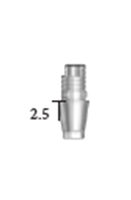
TI-BASE ABUTMENT
Material: Grade 5
G/H : 0.5 - 1.5 - 2.5 -3.5 - 4.5 - 5.5
Ø: 4.1 mm
Connection: Hex-Non Hex
Torque : 25Ncm
TI-BASE FOR MULTI UNIT ABUTMENT
It acts as a stable connection between the implant abutment and the final prosthetic restoration. The Ti-Base provides excellent mechanical strength, high precision fit, and biocompatibility, ensuring long-term stability of the prosthesis.
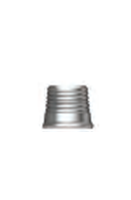
TI-BASE FOR MULTI UNIT ABUTMENT
Hex Driver: 1.25 mm
Material: Grade 5
L : 4.0 - 6.0
Type : A-B
Connection : Non-Hex
Angelation : 5 - 10
SCAN BODY FOR TI-BASE ABUTMENT
It acts as a stable connection between the implant abutment and the final prosthetic restoration. The Ti-Base provides excellent mechanical strength, high precision fit, and biocompatibility, ensuring long-term stability of the prosthesis.

SCAN BODY FOR TI-BASE ABUTMENT
Hex Driver: 1.25 mm
Material: Grade 5
L : 11.0
Ø : 4.0
Connection :Hex
Compatible for all implants
DIGITAL ANALOG
It acts as a stable connection between the implant abutment and the final prosthetic restoration. The Ti-Base provides excellent mechanical strength, high precision fit, and biocompatibility, ensuring long-term stability of the prosthesis.
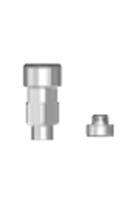
DIGITAL ANALOG
It is used at 3D printed Working Models for implant digital prosthesis
SCAN BODY FOR MULTI-UNIT ABUTMENT
It acts as a stable connection between the implant abutment and the final prosthetic restoration. The Ti-Base provides excellent mechanical strength, high precision fit, and biocompatibility, ensuring long-term stability of the prosthesis.
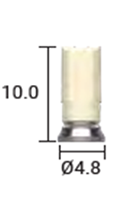
SCAN BODY FOR MULTI-UNIT ABUTMENT
Material: Grade 5
L : 10.0
Ø : 4.8
Connection :Non-Hex
Compatible with multi unit abutmens
DIGITAL ANALOG FOR MULTI UNIT ABT.
It acts as a stable connection between the implant abutment and the final prosthetic restoration. The Ti-Base provides excellent mechanical strength, high precision fit, and biocompatibility, ensuring long-term stability of the prosthesis.
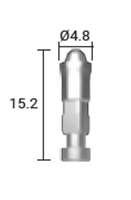
SCAN BODY FOR MULTI-UNIT ABUTMENT
Material: Grade 5
L : 10.0
Ø : 4.8
Connection :Non-Hex
Compatible with multi unit abutmens
 International - English
International - English  Deutschland - Deutsch
Deutschland - Deutsch
 España - Español
España - Español
 France - Français
France - Français
 Italia - Italiano
Italia - Italiano
 Российская Федерация - Русский
Российская Федерация - Русский
 Portugal - Português
Portugal - Português
 Türkiye - Türkçe
Türkiye - Türkçe
 日本 - 日本語
日本 - 日本語
 中国 - 中文
中国 - 中文
